Sweet prickly pear, Indian fig
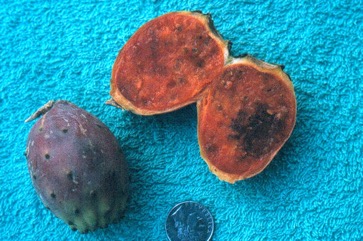
It is native to Mexico. It suits drier places. It needs full sunlight. It needs a temperature above 10°C. It is grown in tropical and subtropical areas. It can grow in arid places. It grows naturally on sandy sea shores. In East Africa it grows below 1,700 m altitude. In Argentina it grows from sea level to 2,500 m above sea level. It suits hardiness zones 9-11. In Sichuan and Yunnan.
Also known as:
Ahntsi, Babutsa, Barbary fig, Bushuki, Chuppauthumoolloo, Ci li, Damtiligi, Divlja smokva, Drooping Prickly pear, Feigenkaktus, Ficarazzi, Fico d'India, Figo de cacto, Figue de barbarie, Gambora, Grabong-pet, Hadami, Holeta, Idolofiya, Kaktus ara indian, Kaktus pir tuna, Kaktus pir variegata, Kaloga, Kij'i'i, Kirigurigu, Kulkual, Lap inciri, Likidindi, Masikio tembo, Mateyak, Matwigampuli, Mfurahisha mkundu, Misir inciri, Mpungate, Mudondoki, Mudoro, Mudorofia, Munanazi, Mwatsa, Nagamala, Ndungantunga, Nkuyuni, Oponce, Opunchia, Papaldotta, Pittara, Prickly pear, Qulqualita, Rangah teen, Saini, Sico tu truncu, Svekrvin jezik, Tarung, Tuna, Tuna mansa, Vialuzungu, Xian tao
Synonyms
- Cactus ficus-indica L.
- Cactus opuntia L.
- Opuntia albicarpa Scgeinvar
- Opuntia castillae Griffiths
- Opuntia incarnadilla Griffiths
- Opuntia occidentalis Engelm.
- Opuntia vulgaris P. Miller
- Platyopuntia vulgaris (P. Miller) F. Ritter
- Cactus compressus R.A. Salisbury
- Opuntia compressa McBride
- Opuntia maxima Salm-Dyck
- ex P. de Candolle
- Opuntia cordobensis Spegazzini
- Platyopuntia cordobensis (Spegazzini) F. Ritter
- Opuntia ficus-indica var. gymnocarpa (F. A. C. Weber) Speg.
- Opuntia tuna-blanca Spegazzini
Edible Portion
- Fruit, Seeds, Stems, Vegetable
Where does Sweet prickly pear grow?
Found in: Africa, Algeria, Andes, Angola, Argentina, Asia, Australia, Balkans, Bolivia, Bosnia, Botswana, Brazil, Canada, Caribbean, Central Africa, Central African Republic, CAR, Central America, Chile, China, Congo DR, Croatia, Cuba, Cyprus, Dominican Republic, East Africa, Ecuador, Egypt, Eritrea, Eswatini, Ethiopia, Europe, Fiji, France, Gibraltar, Greece, Haiti, Hawaii, India, Indochina, Indonesia, Israel, Italy, Jamaica, Jordan, Kenya, Korea, Libya, Madagascar, Malawi, Mauritius, Mediterranean, Mexico, Morocco, Mozambique, Myanmar, Nicaragua, North Africa, North America, Pacific, Pakistan, Paraguay, Peru, Portugal, Puerto Rico, Saudi Arabia, SE Asia, Sicily, Somalia, South Africa, Southern Africa, South America, Spain, St Helena, Sudan, Swaziland, Tanzania, Thailand, Tibet, Tunisia, Turkey, Uganda, Uruguay, United States, Western Sahara, West Africa, West Indies, Yemen, Zambia, Zimbabwe
Notes: There are about 250 Opuntia species. It can be invasive. Fruit are high in folates 24μg/100.
Status: It is a commercially cultivated vegetable. It is sold in local markets.
Growing Sweet prickly pear, Indian fig
Cultivation: Plants are grown from stem pads. They can grow easily from sections which fall onto the ground. Plants can be grown from seeds, by division of the roots or by planting segments.
Edible Uses: The ripe fruit are eaten. Dried fruit are used in sweetmeats. They are also used for jams, jellies and wines. The young stems are used as a vegetable or in pickles. The fermented pulp is mixed with flour and nuts to make and Italian dish. The pulp of the fruit without seeds is prepared as a sauce for pasta. They are also stewed or dried for later use. The green fruit and tender shoots are cooked in curries. They can be eaten in soups and stews to add a mucilaginous character. The segments and fruit can be flamed to remove the spines and hairs.
Production: It takes 5-6 years to fruit when grown from seeds. Fruit matures in 90 days. Fruit can be collected all year round.
Nutrition Info
per 100g edible portion| Edible Part | Energy (kcal) | Protein (g) | Iron (mg) | Vitamin A (ug) | Vitamin c (mg) | Zinc (mg) | % Water |
|---|---|---|---|---|---|---|---|
| Fruit raw | 36 | 0.7 | 0.3 | 5.1RE | 23 | - | 86.4 |
Sweet prickly pear, Indian fig Photos

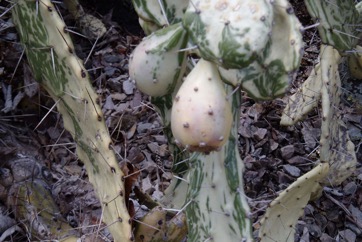
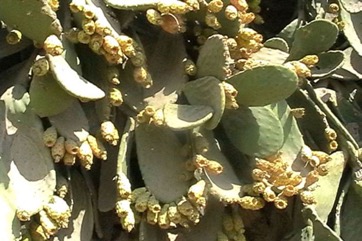
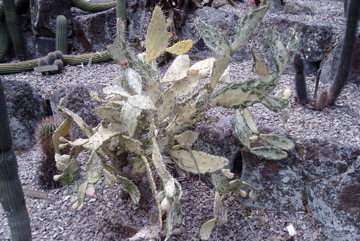
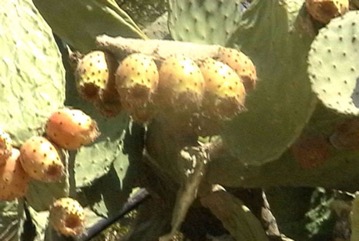
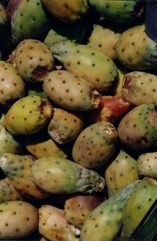
References
Addis, G., et al, 2005, Ethnobotanical Study of Edible Wild Plants in Some Selected Districts of Ethiopia. Human Ecology, Vol. 33, No. 1, pp. 83-118
Addis, G., Asfaw, Z & Woldu, Z., 2013, Ethnobotany of Wild and Semi-wild Edible Plants of Konso Ethnic Community, South Ethiopia. Ethnobotany Research and Applications. 11:121-141
Addis, G., et al, 2013, The Role of Wild and Semi-wild Edible Plants in Household Food Sovereignty in Hamer and Konso Communities, South Ethiopia. Ethnobotany Research & Applications. 11:251-271
Al-Fatimi, M. A., Wild Edible Plants Traditionall Collected and Used in Southern Yemen. Research Square. University of Aden. p 21
Arora, R. K., 2014, Diversity in Underutilized Plant Species - An Asia-Pacific Perspective. Bioversity International. p 79
Asfaw, Z. and Tadesse, M., 2001, Prospects for Sustainable Use and Development of Wild Food Plants in Ethiopia. Economic Botany, Vol. 55, No. 1, pp. 47-62
Ambasta, S.P. (Ed.), 2000, The Useful Plants of India. CSIR India. p 411
Anderson, E.F., 2001, The Cactus Family, Timber Press. p 51, 498
Ashagre, M., et al, 2016, Ethnobotanical study of wild edible plants in Burji District, Segan Area Zone of Southern Nations, Nationalities and Peoples Region (SNNPR), Ethiopia. Journal of Ethnobiology and Ethnomedicine (2016) 12:32
Assefa, A. & Abebe, T., 2010, Wild Edible Trees and Shrubs in the Semi-arid Lowlands of Southern Ethiopia. Journal of Science and Development 1 (1) 2010
Astrada, E., et al, 2007, Ethnobotany in the Cumbres de Monterrey National Park, Nuevo Leon, Mexico. Journal of Ethnobiology and Ethnomedicine 3:8
Balemie, K., & Kebebew, F., 2006, Ethnobotanical study of wild edible plants in Derashe and Kucha Districts, South Ethiopia. Journal of Ethnobiology and Ethnomedicine.
Beckstrom-Sternberg, Stephen M., and James A. Duke. "The Foodplant Database." http://probe.nalusda.gov:8300/cgi-bin/browse/foodplantdb.(ACEDB version 4.0 - data version July 1994) (As Opuntia ficus)
Benson, L., 1969, The Native Cacti of California. Stanford University Press. p 158
Bianchini, F., Corbetta, F., and Pistoia, M., 1975, Fruits of the Earth. Cassell. p 180
Blamey, M and Grey-Wilson, C., 2005, Wild flowers of the Mediterranean. A & C Black London. p 149
Blamey, M and Grey-Wilson, C., 2005, Wild flowers of the Mediterranean. A & C Black London. p 149 (As Opuntia compressa)
Bodkin, F., 1991, Encyclopedia Botanica. Cornstalk publishing, p 744 (Also as Opuntia vulgaris)
Brickell, C. (Ed.), 1999, The Royal Horticultural Society A-Z Encyclopedia of Garden Plants. Convent Garden Books. p 725
Brickell, C. (Ed.), 1999, The Royal Horticultural Society A-Z Encyclopedia of Garden Plants. Convent Garden Books. p 725 (As Opuntia compressa)
Bruschi, P., et al, 2014, Traditional use of plants in a rural community of Mozambique and possible links with Miombo degradation and harvesting sustainability. Journal of Ethnobiology and Ethnomedicine. 2014, 10:59
Burkill, H. M., 1985, The useful plants of west tropical Africa, Vol. 1. Kew. (As Opuntia vulgaris)
Ciftcioglu, C. G., 2015, Sustainable wild-collection of medicinal and edible plants in Lefke region of North Cyprus. Agroforest Syst. Springer
Crawford, M., 2012, How to grow Perennial Vegetables. Green Books. p 139
Creasey, R., 2000, Edible Mexican Garden. Periplus p 51 (As Opuntia compressa)
Creasey, R., 2000, Edible Mexican Garden. Periplus p 51
Cruz, I. M., et al, 2015, Edible fruits and seeds in the State of Mexico. Revista Mexicana de Ciencias Agricolas. Vol. 6. Num. 2 pp 331-346 (Also as Opuntia incarnadilla)
Cundall, P., (ed.), 2004, Gardening Australia: flora: the gardener's bible. ABC Books. p 954
Darley, J.J., 1993, Know and Enjoy Tropical Fruit. P & S Publishers. p 19
de Lucena, et al, 2013, Use and knowledge of Cactaceae in Northeastern Brazil. Journal of Ethnobiology and Ethnomedicine 2013, 9:62
Dharani, N., 2002, Field Guide to common Trees & Shrubs of East Africa. Struik. p 250 (As Opuntia vulgaris)
Dolina, K. & Luczaj, L., 2014, Wild food plants used on the Dubrovnik coast (south-eastern Croatia) Acta Soc Bot Pol 83(3):175–181
Duguma, H. T., 2020, Wild Edible Plant Nutritional Contribution and Consumer Perception in Ethiopia. Hindawi International Journal of Food Science Volume 2020, Article ID 2958623, 16 pages
Ertug, F., 2004, Wild Edible Plants of the Bodrum Area. (Mugla, Turkey). Turk. J. Bot. 28 (2004): 161-174
Esperanca, M. J., 1988. Surviving in the wild. A glance at the wild plants and their uses. Vol. 2. p 160 (As Opuntia vulgaris)
Etherington, K., & Imwold, D., (Eds), 2001, Botanica's Trees & Shrubs. The illustrated A-Z of over 8500 trees and shrubs. Random House, Australia. p 501 (Also as Opuntia vulgaris)
Ethiopia: Famine Food Field Guide. http://www.africa.upenn.edu/faminefood/category1.htm
Facciola, S., 1998, Cornucopia 2: a Source Book of Edible Plants. Kampong Publications, p 65, and p 66 (As Opuntia vulgaris)
FAO, 1988, Traditional Food Plants, FAO Food and Nutrition Paper 42. FAO Rome p 374
Farfan, B., et al, 2007, Mazahua Ethnobotany and Subsistence in the Monarch Butterfly Biosphere Reserve, Mexico. Economic Botany 61(2) 2007, pp 173-191
Feyssa, D. H., et al, 2011, Seasonal availability an consumption of wild edible plants in semiarid Ethiopia; Implications to food security and climate change adaptation. Journal of Horticulture and Forestry 3(5): 138-149
Flora of Australia, Volume 4, Phytolaccaceae to Chenopodiaceae, Australian Government Publishing Service, Canberra (1984) p 72 and p 70 (As Opuntia vulgaris)
Flora Somalia Vol. 1, 1993, http://plants.jstor.org (As Opuntia vulgaris)
Flores, M. P., et al, 2007, Estudio Etnobotanico De Zapotitlan Salinas, Puebla, Acta Botanica Mexicana, Mexico. p 22
Flowerdew, B., 2000, Complete Fruit Book. Kyle Cathie Ltd., London. p 141
Fox, F. W. & Young, M. E. N., 1982, Food from the Veld. Delta Books. p 141 (Also as Opuntia vulgaris)
Gard. dict. ed. 8: Opuntia no. 2. 1768
Grubben, G. J. H. and Denton, O. A. (eds), 2004, Plant Resources of Tropical Africa 2. Vegetables. PROTA, Wageningen, Netherlands. p 563
Gunes, S. et al, 2018, Survey of wild food plants for human consumption in Karaisali (Adana-Turkey). Indian Journal of Traditional Knowledge. Vol. 17(2), April 2018, pp 290-298
Gurdal, B. & Kultur, S., 2014, The edible and miscellaneous useful plants in Marmaris (Southwest Turkey). İstanbul Ecz. Fak. Derg. / J. Fac. Pharm. Istanbul 44(1) 2014 pp.69-78
Hani Medicine of Xishuangbanna, 1999, p 755 (As Opuntia vulgaris)
Hedrick, U.P., 1919, (Ed.), Sturtevant's edible plants of the world. p 450 (As Opuntia engelmanni and Opuntia vulgaris)
Hermandez Bermejo, J.E., and Leon, J. (Eds.), 1994, Neglected Crops. 1492 from a different perspective. FAO Plant Production and Protection Series No 26. FAO, Rome. p15
Hibbert, M., 2002, The Aussie Plant Finder 2002, Florilegium. p 215
Hu, Shiu-ying, 2005, Food Plants of China. The Chinese University Press. p 568
INFOODS:FAO/INFOODS Databases
Innes, C. and Glass, C., 1997, The Illustrated Encyclopedia of Cacti. Sandstone Books. p 214
Jardin, C., 1970, List of Foods Used In Africa, FAO Nutrition Information Document Series No 2.p 151 (Also as Opuntia tuna and Opuntia vulgaris)
John, L., & Stevenson, V., 1979, The Complete Book of Fruit. Angus & Robertson p 157 (Also as Opuntia vulgaris)
Kays, S. J., and Dias, J. C. S., 1995, Common Names of Commercially Cultivated Vegetables of the World in 15 languages. Economic Botany, Vol. 49, No. 2, pp. 115-152
Khan, D. & Shaukat, S.S., 2006, The Fruits of Pakistan: Diversity, Distribution, Trends of Production and Use. Int. J. Biol. Biotech., 3(3):463-499
Larios, et al., 2013, Plant management and biodiversity conservation in Náhuatl homegardens of the Tehuacán Valley, Mexico. Journal of Ethnobiology and Ethnomedicine 2013 9:74.
Latham, P & Mbuta, A., 2017, Useful Plants of Central Province, Democratic Republic of Congo. Volume 2. Salvation Army p 75
Lautenschläger, T., et al, 2018, First large-scale ethnobotanical survey in the province of Uíge, northern Angola. Journal of Ethnobiology and Ethnomedicine (2018) 14:51
Lazarides, M. & Hince, B., 1993, Handbook of Economic Plants of Australia, CSIRO. p 175 and p 176 (As Opuntia vulgaris)
Long, C., 2005, Swaziland's Flora - siSwati names and Uses http://www.sntc.org.sz/flora/
Lopez-Palacios, C., et al, 2016, Rheological Flow Behavior of Structural Polysaccharides from Edible Tender Cladodes of Wild, Semidomesticated and Cultivated ‘Nopal’ (Opuntia) of Mexican Highlands. Plant Foods for Human Nutrition. Vol. 71, Issue 4, pp 388-395
Lorenzi, H., Bacher, L., Lacerda, M. & Sartori, S., 2006, Brazilian Fruits & Cultivated Exotics. Sao Paulo, Instituto Plantarum de Estuados da Flora Ltda. p 371
Low, T., 1992, Bush Tucker. Australia’s Wild Food Harvest. Angus & Robertson. p 74 (As Opuntia vulgaris)
Lulekal, E., et al, 2011, Wild edible plants in Ethiopia: a review on their potential to combat food insecurity. Afrika Focus - Vol. 24, No 2. pp 71-121
Lyle, S., 2006, Discovering fruit and nuts. Land Links. p 303 (Also as Opuntia compressa)
Magwede, K., van Wyk, B.-E., & van Wyk, A. E., 2019, An inventory of Vhavenḓa useful plants. South African Journal of Botany 122 (2019) 57–89
Marinelli, J. (Ed), 2004, Plant. DK. p 464
Martin, F. W., et al, 1987, Perennial Edible Fruits of the Tropics. USDA Handbook 642 p 22
McMakin, P.D., 2000, Flowering Plants of Thailand. A Field Guide. White Lotus. p 73 (As Opuntia vulgaris)
Moerman, D. F., 2010, Native American Ethnobotany. Timber Press. p 366
Maroyi, A., 2011, The Gathering and Consumption of Wild Edible Plants in Nhema Communal Area, Midlands Province, Zimbabwe. Ecology of Food and Nutrition 50:6, 506-525
Maroyi, A. & Cheikhyoussef, A., 2017, Traditional knowledge of wild edible fruit in southern Africa: A comparative use patterns in Namibia and Zimbabwe. Indian Journal of Traditional Knowledge. 16(3): 385-392
Mengistu, F. & Hager, H., 2008, Wild Edible Fruit Species Cultural Domain, Informant Species Competence and Preference in Three Districts of Amhara Region, Ethiopia. Ethnobotany Research & Applications 6:487-502
Mokganya, M. G. et al, 2018, An evaluation of additional uses of some wild edible fruit plants of the Vhembe District Municipality in the Limpopo Province, South Africa. Indian Journal of Traditional Knowledge. Vol 17(2) April 2018, pp 276-281
Molla, A., Ethiopian Plant Names. http://www.ethiopic.com/aplants.htm (As Opuntia vulgaris)
Montani, M. C. & Scarpa, G. F., 2016, Recursos vegetales y prácticas alimentarias entre indígenas tapiete del noreste de la provincia de Salta, Argentina. Darwiniana, nueva serie vol.4 no.1 San Isidro jul. 2016
Morley, B.D., & Toelken, H.R., (Eds), 1983, Flowering Plants in Australia. Rigby. p 74 (As Opuntia vulgaris)
Nebel, S., Pieroni, A. & Heinrich, M., 2006, Ta cho`rta: Wild edible greens used in the Graecanic area in Calabria, Southern Italy. Appetite 47 (2006) 333–342
Paczkowska, G. & Chapman, A.R., 2000, The Western Australian Flora. A Descriptive Catalogue. Western Australian Herbarium. p 190 (As Opuntia vulgaris)
Pakia, M., 2000, Plant Ecology and Ethnobotany of two sacred forests (Kayas) at the Kenya Coast. M. Sc. Thesis. (As Opuntia vulgaris)
Perry, F., and Hay, R., 1982, Guide to Tropical and Subtropical Plants. Sun Books p 70 (As Opuntia vulgaris)
Plants for a Future database, The Field, Penpol, Lostwithiel, Cornwall, PL22 0NG, UK. http://www.scs.leeds.ac.uk/pfaf/ (Also as Opuntia compressa)
Polini, G., et al, Useful and edible plants of Paraguay Region of Chaco. p 43
Quintana, C. M., 2010, Wild Plants in the Dry Valleys Around Quito Ecuador. An Illustrated Guide. Publicationes del Harbario, QCA p 97
Redzic, S. J., 2006, Wild Edible Plants and their Traditional Use in the Human Nutrition in Bosnia-Herzegovina. Ecology of Food and Nutrition, 45:189-232
Rodriguez-Felix, A. & Cantwell, M., 1988, Developmental changes in composition and quality of prickly pear cactus cladodes (nopalitos). Plant Foods for Human Nutrition 38:83-93
Royal Botanic Gardens, Kew (1999). Survey of Economic Plants for Arid and Semi-Arid Lands (SEPASAL) database. Published on the Internet; http://www.rbgkew.org.uk/ceb/sepasal/internet [Accessed 5th April 2011]
Ruiters-Welcome, A. K., 2019, Food plants of southern Africa. Ph.D. thesis. Univ. of Johannesburg p 41
Saunders, C.F., 1948, Edible and Useful Wild Plants. Dover. New York. p 108 (Also as Opuntia vulgaris)
Scarpa, G. F., 2009, Wild food plants used by the indigenous peoples of South American Gran Chaco: A general synopsis and intercultural comparison. Journal of Applied Botany and Food Quality 83:90-101
Schmidt, E., Lotter, M., & McCleland, W., 2007, Trees and shrubs of Mpumalanga and Kruger National Park. Jacana Media p 440
Schneider, E., 2001, Vegetables from Amaranth to Zucchini: The essential reference. HarperCollins. p 139
Segura, S. et al, 2018, The edible fruit species in Mexico. Genet Resour Crop Evol (2018) 65:1767–1793 (Also as Opuntia albicarpa and Opuntia incarnadilla)
Seyoum, Y., et al, 2015, Edible Wild Fruit Trees and Shrubs and Their Socioeconomic Significance in Central Ethiopia. Ethnobotany Research & Applications. 14:183-197
SHORTT, (As Opuntia vulgaris)
Shumsky, S., et al, 2014, Institutional factors affecting wild edible plant (WEP) harvest and consumption in semi-arid Kenya. Land Use Policy 38(2014) 48-69
Smith, A.C., 1981, Flora Vitiensis Nova, Lawaii, Kuai, Hawaii, Volume 2 p 271 (As Opuntia vulgaris)
Striegel, L., et al, 2019, Promising Tropical Fruits High in Folates. Foods 2019, 8, 363; doi:10.3390/foods8090363. www.mdpi.com/journal/foods
Sukarya, D. G., (Ed.) 2013, 3,500 Plant Species of the Botanic Gardens of Indonesia. LIPI p 1038 (As Opuntia vulgaris)
Sukarya, D. G., (Ed.) 2013, 3,500 Plant Species of the Botanic Gardens of Indonesia. LIPI p 1036
Subik, R. & Kunte, L., 2003, The Complete Encyclopedia of Cacti. Rebo International. p 13
Swaziland's Flora Database http://www.sntc.org.sz/flora
Thomas, E., et al, 2008, The Relationship Between Plant Use and Plant Diversity in the Bolivian Andes, with Special Reference to Medicinal Plant Use. Hum Ecol (2008) 36:861–879
Thomas, E., et al, 2009, The relation between accessibility, diversity and indigenous valuation of vegetation in the Bolivian Andes. Journal of Arid Environments. 73:854-861
Toledo, B. A., et al, 2007, Knowledge and Use of Edible and Medicinal Plants in two Populations from the Chaco Forest, Cordoba Province, Argentina. Journal of Ethnobiology 27(2):218-232
Tredgold, M.H., 1986, Food Plants of Zimbabwe. Mambo Press. p 80
USDA, ARS, National Genetic Resources Program. Germplasm Resources Information Network - (GRIN). [Online Database] National Germplasm Resources Laboratory, Beltsville, Maryland. Available: www.ars-grin.gov/cgi-bin/npgs/html/econ.pl (10 April 2000)
Van den Eynden, V., et al, 2003, Wild Foods from South Ecuador. Economic Botany 57(4): 576-603
van Wyk, B., 2005, Food Plants of the World. An illustrated guide. Timber press. p 267
van Wyk, Be., & Gericke, N., 2007, People's plants. A Guide to Useful Plants of Southern Africa. Briza. p 50
Van Wick, B. & Van Wick, P., 2009, Filed Guide to Trees of Southern Africa, Struik Nature. p 36
Vasquez, Roberto Ch. & Coimbra, German S., 1996, Frutas Silvestres Comestibles de Santa Cruz. p 247
Vivien, J., & Faure, J.J., 1996, Fruitiers Sauvages d'Afrique. Especes du Cameroun. CTA p 95
Weckerle, C. S., et al, 2006, Plant Knowledge of the Shuhi in the Hengduan Mountains, Southwest China. Economic Botany 60(1):2-23
Wehmeyer, A. S, 1986, Edible Wild Plants of Southern Africa. Data on the Nutrient Contents of over 300 species
Williamson, J., 2005, Useful Plants of Malawi. 3rd. Edition. Mdadzi Book Trust. p 179 (As Opuntia vulgaris)
World Checklist of Useful Plant Species 2020. Royal Botanic Gardens, Kew
www.chileflora.com
www.colecionandofrutas.org (As Opuntia vulgaris)
www.wildediblefood.com
www.worldagroforestrycentre.org/treedb/
www.zimbabweflora.co.zw 2011